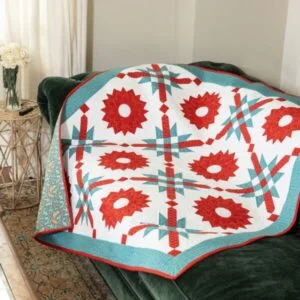Are you looking for a fun and eye-catching quilting project? The Hexagon Flower Quilt Block – Tutorial is the perfect guide to help you create beautiful quilt blocks with a floral, geometric design.
The hexagon flower quilt block is an iconic pattern that adds a vibrant, intricate look to any quilt. Whether you’re a beginner or an experienced quilter, this tutorial will show you how to construct these blocks step by step.
The Hexagon Flower Quilt Block is made up of small hexagons that fit together to form a larger flower-like design.

These blocks can be used in a variety of quilt styles, from traditional to modern, and allow for endless possibilities in terms of fabric combinations and layouts. Each block typically features a central hexagon surrounded by six additional hexagons, creating a dynamic floral effect.
In this Hexagon Flower Quilt Block – Tutorial, we’ll cover everything you need to know to get started, from selecting fabrics to cutting, piecing, and assembling the blocks. We’ll also give you tips on how to achieve perfect points and avoid common mistakes. Let’s dive in and bring these hexagonal flowers to life!
1. Materials and Fabric Selection for Hexagon Flower Quilt Block
Before we start creating the Hexagon Flower Quilt Block, it’s essential to gather the necessary materials and choose your fabrics wisely. The success of this project depends heavily on your fabric selection and tools.
- Choosing Fabrics: The hexagon flower quilt block allows for creative fabric use. You’ll need at least two contrasting fabrics to make the flower pattern stand out. For a more vibrant look, choose multiple bright colors and prints. If you prefer a more classic or subdued quilt, go for soft pastels or neutral tones. The contrast between the center hexagon and the surrounding petals will help the flower design pop.
- Fabric Yardage: The amount of fabric needed depends on the number of quilt blocks you plan to make. Typically, fat quarters or fabric scraps are ideal for creating hexagon blocks. Plan on using about 1 yard of fabric for a small throw quilt with multiple hexagon blocks.
- Templates and Cutting Tools: A hexagon template or quilting ruler is necessary for cutting accurate hexagon shapes. You’ll also need a rotary cutter, cutting mat, and quilting ruler to ensure precision in your cuts. Alternatively, if you don’t have a hexagon template, you can trace a hexagon shape onto cardboard and use it to cut your fabric pieces.
- Needle and Thread: For hand piecing, a sharp needle and strong quilting thread are essential. If you plan to machine piece, a sewing machine with a quarter-inch foot will give you clean seams. Use thread that complements your fabric or blends in with the background.
- Paper Pieces for English Paper Piecing: If you choose to use the English Paper Piecing (EPP) method, you’ll need paper templates that match the size of your hexagons. These are easy to find online or in quilt shops. The paper pieces help keep your hexagons uniform and make it easier to sew them together by hand.
- Pins and Clips: When piecing hexagons, especially if you’re hand-sewing them, pins and clips can help hold the shapes in place. Precision is crucial in creating the hexagon shapes, so secure your pieces well.
Now that your materials are ready, let’s move on to cutting and preparing the hexagons for assembly.
2. Cutting and Preparing the Hexagon Flower Quilt Block
Once your fabric is selected, the next step in this Hexagon Flower Quilt Block – Tutorial is to cut and prepare the hexagon pieces for assembly. This process requires attention to detail but is quite simple once you get the hang of it.
- Cutting Hexagons: Using your hexagon template, carefully cut the hexagons from your fabric. The size of the hexagon is up to you, but typically a 2-3 inch hexagon works well for most quilts. Cut out one central hexagon for the center of the flower and six more for the surrounding petals. Keep your cuts as clean and precise as possible to avoid uneven shapes.
- Marking Seam Allowances: If you are using the English Paper Piecing (EPP) method, you’ll want to cut your fabric hexagons slightly larger than the template to account for seam allowances. Mark a quarter-inch seam allowance around each fabric hexagon. This step is critical for accurate piecing.
- Basting for English Paper Piecing: Basting is a key step in the EPP method. Place each fabric hexagon over its paper piece and fold the fabric edges over the paper, basting them in place with large, loose stitches. This technique helps to hold the shape until you’re ready to sew the hexagons together.
- Creating Perfect Points: When preparing your hexagons, pay close attention to the corners, as these need to meet neatly when assembling the quilt block. Use clips to secure the edges if necessary, and be mindful of keeping your points sharp.
- Cutting Without Templates: If you don’t have access to a template, you can make one by tracing a hexagon shape onto cardboard. Cut out the cardboard hexagon and use it as a guide for cutting your fabric.
- Pressing Hexagons: Once your hexagons are cut and basted, give them a light press with an iron. Pressing will help to set the folds in place and ensure your pieces stay flat during assembly.
With your hexagons prepared, you’re ready to start piecing them into the flower block.
3. Assembling the Hexagon Flower Quilt Block
The assembly process for the Hexagon Flower Quilt Block is one of the most satisfying steps in this project. This is where your hexagons come together to form the floral design.
- Layout of Hexagons: Begin by laying out your hexagons on a flat surface. Place the central hexagon in the middle and arrange the six surrounding hexagons around it, forming the petals of the flower. Adjust the placement until you’re satisfied with the layout and color arrangement.
- Sewing Hexagons by Hand: For English Paper Piecing (EPP), sew the hexagons together by hand using a whipstitch. Start with one of the surrounding hexagons and sew it to the central hexagon. Use small, tight stitches to ensure the seams are strong and secure. Continue attaching each surrounding hexagon to the central one until the flower shape is complete.
- Machine Sewing Hexagons: If you prefer to machine sew, use a quarter-inch seam allowance. Begin by joining two hexagons along one edge. Sew slowly and carefully to keep the points aligned. Press each seam as you go, pressing toward the darker fabric.
- Joining Flower Blocks: Once your flower block is complete, you can either finish the quilt block by adding a border or sew multiple flower blocks together to form a larger quilt top. When joining multiple blocks, align the seams carefully to keep the hexagon shapes intact.
- Achieving Sharp Points: The key to a successful Hexagon Flower Quilt Block is achieving sharp points where the hexagons meet. Take your time aligning the pieces and press each seam to keep the edges crisp.
- Pressing the Final Block: After all the hexagons are sewn together, give the block one final press. Pressing the block helps to set the seams and give the quilt block a smooth, professional finish.
With the assembly complete, your Hexagon Flower Quilt Block is ready to be turned into a beautiful quilt.
4. Adding Borders, Backing, and Finishing the Quilt
Now that you’ve completed your Hexagon Flower Quilt Block, it’s time to finish the quilt by adding borders, backing, and quilting the layers together.
- Adding a Border: If you’d like to frame your hexagon flower block, you can add a border around the edges. A simple solid color or a complementary fabric pattern can help to enhance the block design and give your quilt a polished look. Measure your block carefully and cut fabric strips for the border.
- Choosing Backing Fabric: Select a backing fabric that complements the design of your quilt top. For a vibrant quilt top, you might want to choose a neutral or solid backing fabric. If you prefer a more coordinated look, choose a fabric that ties in with the colors of the hexagons.
- Quilting the Layers Together: Layer your quilt top, batting, and backing fabric to create a quilt sandwich. Use safety pins or basting spray to secure the layers in place. Quilting the layers together can be done either by hand or with a sewing machine. Simple straight-line quilting works well for this block, or you could use free-motion quilting for a more artistic finish.
- Binding the Edges: Finish the quilt by adding a binding around the edges. Cut binding strips and sew them to the edge of the quilt, folding them over and stitching in place for a clean finish.
- Pressing the Final Quilt: Once your quilt is complete, give it a final press to remove any wrinkles and set the seams.
- Displaying Your Quilt: Your Hexagon Flower Quilt Block is now ready to be displayed! Whether it’s a small throw quilt, a wall hanging, or part of a larger project, this flower block adds a unique and beautiful touch.
FAQ About Hexagon Flower Quilt Block
What is the best size for hexagons in a flower quilt block?
Hexagons typically range from 2-3 inches in size, but you can adjust based on the look you want for your quilt. Smaller hexagons create a more intricate design, while larger hexagons make the quilt faster to assemble.
Can I make a hexagon flower quilt block without using paper templates?
Yes! While English Paper Piecing is a popular method, you can also cut hexagons directly from fabric and piece them together with a sewing machine. Using a hexagon ruler will help you achieve accurate cuts.
What fabrics work best for a hexagon flower quilt block?
Cotton fabrics are most commonly used in quilting, but feel free to experiment with other materials like linen or silk. The key is choosing contrasting fabrics that highlight the flower design.
How do I avoid puckering when sewing hexagons together?
To avoid puckering, make sure your seam allowances are accurate and consistent. If you’re hand sewing, use tight, small stitches, and if you’re using a machine, sew slowly to ensure the fabric doesn’t bunch.
Do I need a special sewing machine foot for piecing hexagons?
A quarter-inch foot is helpful for piecing hexagons with a sewing machine as it ensures you sew the correct seam allowance. It isn’t necessary, but it can make your seams more precise.
How do I make sure my points are sharp in the hexagon flower quilt block?
Pressing your seams and carefully aligning the edges of each hexagon is key to achieving sharp points. Take your time to ensure accuracy during both cutting and sewing.
Join our VIP broadcast list and gain access to exclusive patterns, all for free. As a VIP member, you’ll receive the best patterns daily, delivered directly to your device. ✨📱 It’s a unique opportunity to stay up-to-date with the latest trends and designs, curated just for you. Don’t miss out on enhancing your projects and discovering new inspirations with the best patterns every day! 🎨🔝
Conclusion
We hope this Hexagon Flower Quilt Block – Tutorial has inspired you to try this beautiful, timeless quilt design. From selecting fabrics to piecing hexagons together, we’ve walked you through each step to ensure your quilting journey is successful.
Please share your experiences with this tutorial in the comments and let us know any suggestions for future projects. Happy quilting!



